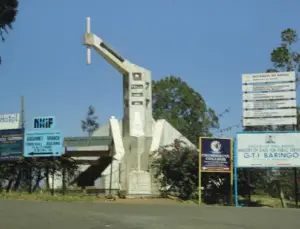Kabarnet
 The town is named after a missionary, Barnet, from the Alsace ,France .The locals who are Tugen sub-tribe of the larger Kalenjin added the prefix ‘Ka’ meaning homestead ,thus Kabarnet -homestead of Barnet.It was the administrative headquarters for Baringo district since 1907, when the colonial government made it the seat of the local government.
The town is named after a missionary, Barnet, from the Alsace ,France .The locals who are Tugen sub-tribe of the larger Kalenjin added the prefix ‘Ka’ meaning homestead ,thus Kabarnet -homestead of Barnet.It was the administrative headquarters for Baringo district since 1907, when the colonial government made it the seat of the local government.At an altitude of 1,815m, Kabarnet is located on the eastern edge of the Kerio valley. The view of Tugen hills is spectacular along the road heading west from Marigat. Views include east over the rift valley towards Lake Baringo and lake Bogoria, and west to the Elgeyo escarpment and the kerio valley.
The Kabarnet area is home to the Samors ,a sub-group of the Tugen community.
The town has seven kindergartens, twenty primary schools(with eight grades),schools foe the deaf and handicapped, three secondary schools and two polytechnics.During the rainy season, most wild trees surrounding the town ,which give it a lush green atmosphere ,bear wild fruits and birds flock to it likes bees to a honey comb. Visitors to the town marvel at the thousands of chirping birds that have made the hills surrounding it a bird watchers heaven. A research conducted discovered that the birds, which are of unique sizes and colours are the earliest species to wake up in Africa. Kabarnet towns environs have a wide range of wildlife , breathtaking water falls, numerous campsites and exiting topography with spectacular gorges. Its location is in close proximity to various attractive scenes, which include Lake Bogoria ,Lake Baringo, and the Tugen hills. Lake Bogoria where visitors can see boiling geothermal geysers , hot springs and steam jets, is only a 45 min drive from the town , while Lake Baringo famed for its islands , wildlife , and hundreds of bird species , is only 30 minutes away.
“The region is a rich tourist destination and no serious effort to tap it has been undertaken,” says Mr. john kimosop,of the local council.
Driving to Kabarnet, the view of Tugen hills is spectacular and the imposing elgeiyo escarpment is magnificent.
BEE KEEPING
Residents of the semi arid parts of the region are mainly pastoralists, while those who live in the highlands practice large scale coffee and maize farming.
“most parts of the region are semi arid and people keep livestock, especially goats and zebu cows,” says Mr. Charles kamuren.
Kamuren says the region is also well known as honey harvesting zone, because the expensive bush surrounding it is ideal for bee keeping.
“it is one of the best honey harvesting zone in the country and a visitor to the region can not return home without natural honey, fresh from the locally made beehives,” he says.
Kabarnet became a municipality in 1984 and the local mayor, Mr. Julius kiprop,says, despite its potential, they face many challenges like lack of sewerage system.
For the last 24 years, the town, which has a population of 30,000, has operated without a sewer line.
“we have made progresses and soon we will have sewer lines that will settle this problem,” he said.
The town has a museum, which displays elements from local culture and traditions, as well as information on l Baringo and its environment.
Kabarnet museum was opened in 1996 and has four main public galleries featuring the people of the Rift Valley, their culture, indigenous knowledge and the science of education.
The main attractions of the museum are the exhibits, especially on the culture of the Keiyo, Marakuet, Samburu, Pokot, Nandi and the Kipsigis.
In addition to this, some literature of the district’s history from pre-colonial, colonial, and post independence on display.
The gardens surrounding Kabarnet museum are so green and lush it has become a small botanical park.
Prehistoric human bones have also been discovered here, placing the town among places with rich archaeological value.
Borodin Tugenensis, which was discovered in a small village in Kabarnet town, is considered among the oldest possible modern human ancestors.
RENDERED JOBLESS
Though it could have been a global attraction, the artifacts are flown to Frances, denying the town its place in the history of mankind.
Despite the towns’ scenic sites, it almost fell to its knees economically, when the former the former president retired from politics in 2002.
Most industries, which operated in the area and employed thousands of people, have gone under, crippling Kabarnet’s growth.
Industries such as Makatiat, a large bakery, as well as hides and skin industries collapsed, disestablishing the area’s economy.
“these industries employed several hundred people, who were rendered jobless after they closed down six years ago,” says Kamuren.
Cotton was the livelihood of those living in Kerio Valley lowlands, but the collapse of Salawa Ginnery put an end to that.
The cash crop was the lifeline of people residing in Kapluk, Chesongo, Bartabwa, Salawa and Barwessa.
Efforts to retrieve the ginnery have proved fruitless, after farmers boycotted planting the crop, due to the low prices it fetches.
